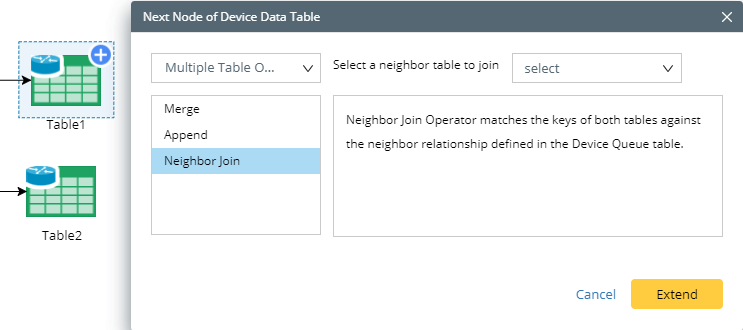R12 Publication-2025July16
Configuring Neighbor Join Operator
This section introduces how to use the Neighbor Join operator to join table data of a device and its neighbor into a new table for comparison.
- Point to the Table1 node, click the
 icon, select Multiple Table Operator > Neighbor Join, select the table to join and click Extend.
icon, select Multiple Table Operator > Neighbor Join, select the table to join and click Extend. 
- At the Neighbor Join node, adjust the matching keys of two tables based on the variable name in the Device Queue node. If a variable is incorrectly matched, point to the key and click the
 icon to select a new key.
icon to select a new key.
- Extend a Basic Output node from the Table3 node and define the conditions to trigger the output.
- Click the Output node and then click New Condition.
- In the Define Condition dialog, define conditions as follows:
- $this_mtu != $nbr_mtu

Tip: != means not equal to. - $this_bw != $nbr_bw
- Boolean Expression: A or B
- Extend a Draw Note node from the Output1 node and define it as follows:
- Unselect the Map Note check box, and then select the Interface Note check box.
- Select $this_device in the Device field, and then select $this_intf in the Interface field.
- Enter the title of the note: Neighbor MTU/Bandwidth Mismatch.
- Enter the content of the note. For example:
This Interface mtu: $this_mtu <------> neighbor interface mtu: $nbr_mtu
This Interface speed $this_bw <------> neighbor interface speed $nbr_bw
5. Save and run the Qapp on a map. After the Qapp execution is finished, devices with mismatched MTU or bandwidth value will be attached with a note.